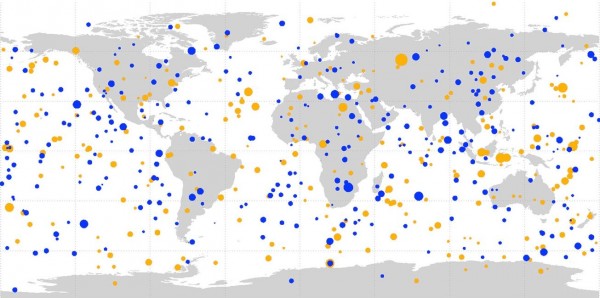
NASA’s Near Earth Object (NEO) Program released this new map on November 14, 2014. It shows what more and more people are beginning to realize: that small asteroids enter Earth’s atmosphere frequently. Indeed, we on Earth are located in what astronomers at Armagh Observatory in Northern Ireland have called the cosmic shooting gallery. What happens to these asteroids, and why didn’t we know this before? Many of the impacts are seen and reported as fireballs. Nearly all burn up in Earth’s atmosphere; that is, our atmosphere does its job in protecting us from what would otherwise be impacts to Earth itself. The notable exception was the Chelyabinsk meteor on February 15, 2013. It was the largest asteroid to hit Earth in this period (about 20 meters in size before it hit the Earth). The Chelyabinsk meteor broke windows in some 7,200 buildings in six Russian cities and caused the injury of at least 1,500 people, mostly from shattered glass.
The new map above shows that atmospheric impacts by small asteroids are randomly distributed around the globe. The map is a visualization of data gathered by U.S. government sensors from 1994 to 2013. The data indicate that small asteroids struck Earth’s atmosphere – resulting in what astronomers call a bolide (a fireball, or bright meteor) – on 556 separate occasions in a 20-year period. Almost all asteroids of this size disintegrate in the atmosphere and are usually harmless. NASA says:
The new data could help scientists better refine estimates of the distribution of the sizes of NEOs [near Earth objects] including larger ones that could pose a danger to Earth.
On this map, the size of the dots are proportional to the optical radiated energy of the impact event measured in billions of Joules (GJ) of energy. NASA says:
An approximate conversion between the measured optical radiant energy and the total impact energy can be made using an empirical relationship provided by Peter Brown and colleagues in 2002. For example the smallest dot on the map represents 1 billion Joules (1 GJ) of optical radiant energy, or when expressed in terms of a total impact energy the equivalent of about 5 tons of TNT explosives. Likewise, the dots representing 100, 10,000 and 1,000,000 Giga Joules of optical radiant energies correspond to impact energies of about 300 tons, 18,000 tons and one million tons of TNT explosives respectively.
NASA adds that finding and characterizing hazardous asteroids to protect our home planet is a high priority for the space agency. It is one of the reasons that NASA is now spending 10 times more than it was five years ago on asteroid detection, characterization and mitigation.
In addition, NASA says it has:
… aggressively developed strategies and plans with its partners in the U.S. and abroad to detect, track and characterize Near Earth Objects. These activities also will help identify NEOs that might pose a risk of Earth impact, and further help inform developing options for planetary defense.
We can only hope so. If you like, you can help participate in the hunt for potentially hazardous NEOs through the Asteroid Grand Challenge, which, NASA says:
… aims to create a plan to find all asteroid threats to human populations and know what to do about them.
NASA is also pursuing an Asteroid Redirect Mission (ARM) which will identify, redirect and send astronauts to explore an asteroid. Among its many exploration goals, the mission could demonstrate basic planetary defense techniques for asteroid deflection. See the video below for more about this mission.
Read more from NASA about the new map showing asteroid impacts to Earth’s atmosphere
Bottom line: A new map from NASA helps visualize bolide – fireball or bright meteor – data gathered by U.S. government sensors from 1994 to 2013. The data indicate that small asteroids struck Earth’s atmosphere on 556 separate occasions in a 20-year period.











